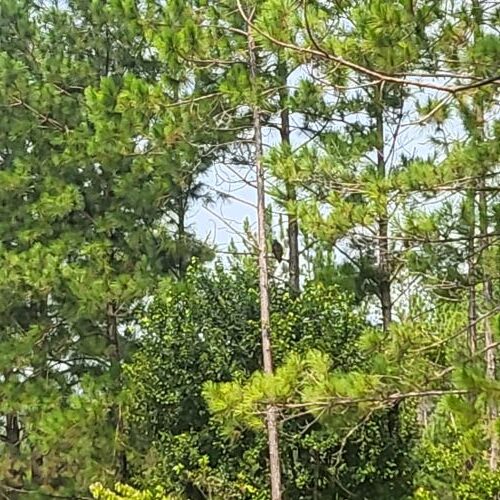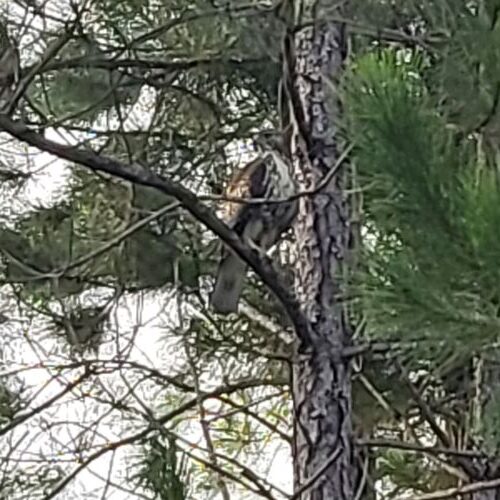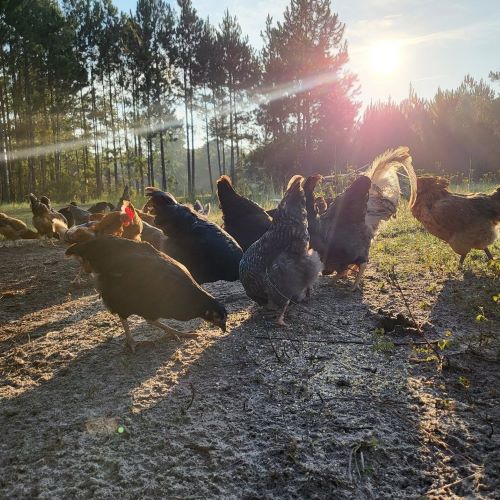Wings vs. Clucks: Protecting Free-Range Chickens from Aerial Predators
As a proud chicken keeper and advocate of free-ranging practices, I have come to appreciate the countless benefits and rewards that come with allowing our feathered friends to roam and explore. There’s something special about watching them peck and scratch, reveling in their natural behaviors and experiencing a sense of freedom. However, along with the joys of free-ranging chickens, we must also acknowledge the presence of a formidable adversary: predatory birds.
These aerial hunters, specifically birds of prey, can pose significant challenges to the safety and well-being of our beloved flock. Their keen eyesight, impressive flight skills, and predatory instincts make them a constant threat to our free-ranging chickens. As we strive to strike a balance between the benefits of allowing our chickens to roam and the responsibility of protecting them, it becomes crucial to develop practical and effective strategies to safeguard our poultry from these aerial predators.

Intended Purpose
In this article, we will delve into the world of wings and clucks, exploring ways to protect free-range chickens from the ever-watchful eyes of predatory birds. Our focus will primarily be on birds of prey, the majestic hunters that gracefully patrol the skies in search of their next meal. We will delve into the potential challenges posed by these predators and offer actionable steps to help ensure the safety and security of our feathered companions.
However, our goal goes beyond merely repelling predators; it is to foster an environment of coexistence, where both the predator and the flock can thrive within our shared ecosystem. We believe that it is possible to strike a balance that prioritizes the safety of our chickens while respecting the natural behavior and role of these predatory birds.
Throughout this article, we will provide practical advice, valuable insights, and innovative solutions to empower you as a chicken keeper. Together, we will explore the protective measures that can be implemented to shield our free-ranging chickens from the watchful gaze of birds of prey. We will emphasize the importance of finding solutions that ensure the safety of both the predator and the flock, promoting a harmonious coexistence in our diverse ecosystem.
So, fellow chicken enthusiasts, let’s embark on this journey together as we discover the strategies that will safeguard our feathered companions from the aerial predators that share our skies. By implementing these practical measures, we can protect our free-ranging chickens while preserving the rewards and benefits of this delightful practice. Let’s dive in and explore the fascinating world of wings versus clucks!
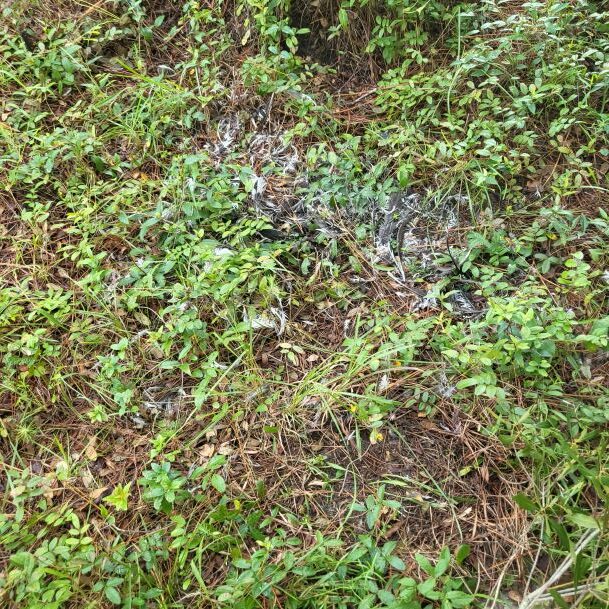
Birds of Prey
As we delve into the realm of protecting our free-range chickens, it is essential to understand the characteristics and behavior of birds of prey, the aerial hunters that pose a significant threat to our flock’s safety. These majestic predators possess a set of skills and instincts that make them formidable adversaries.
Characteristics of Good Prey
Birds of prey are naturally drawn to certain characteristics that make chickens an appealing target. From their perspective, chickens exhibit the ideal traits of a vulnerable prey species. Their relatively small size, ground-dwelling nature, and slow movement make them an enticing meal option for these aerial hunters. Additionally, the contrast in colors and patterns on a chicken’s plumage can attract the attention of birds of prey, further increasing their vulnerability.
Ideal Hunting Areas
To maximize their hunting success, birds of prey tend to seek out specific environments that provide optimal conditions for spotting and capturing prey. Open spaces, such as pastures or fields, offer unobstructed views, allowing them to survey the area for potential targets. These predators prefer habitats where chickens may be exposed and lack protective cover, increasing their chances of a successful hunt.
Preferred Hunting Times
Birds of prey have distinct hunting patterns and active periods that coincide with their natural instincts and favorable environmental conditions. They are often most active during the early morning and late afternoon, when their keen eyesight is enhanced by the angle and quality of the sunlight. These periods provide them with optimal visibility and hunting efficiency. It is important for chicken keepers to be aware of these peak hunting times and take necessary precautions to minimize the risks for their free-ranging flock.
Understanding the characteristics that make chickens attractive to birds of prey, the preferred hunting areas these predators seek out, and their preferred hunting times sets the stage for implementing effective protective measures. By gaining insight into their behavior, we can better strategize and implement measures that mitigate the risks and create a safer environment for our free-range chickens.
Now, let’s move forward and explore the signs that indicate our flock may be under the watchful eyes of predatory birds, ensuring we remain vigilant in protecting our cherished feathered companions.
II. Signs Your Flock Is Being Stalked
As vigilant chicken keepers, it is essential to be able to recognize the signs that indicate our free-range flock may be under the watchful eyes of predatory birds. By staying attuned to these subtle cues, we can take prompt action to protect our chickens from potential harm.
- Birds Huddling Together Quietly One of the signs that our flock may be under the watchful eyes of predatory birds is when we notice our chickens huddling together in an unusually quiet manner. Birds have a remarkable ability to communicate non-verbally, and when they sense a potential threat, they may become silent and seek safety in numbers. Pay attention to their behavior during free-ranging sessions and observe if they appear unusually still and cautious.
- Hanging Very Close to the Coop or Roosting During the Day Another indication that predatory birds may be stalking our flock is when we observe our chickens staying close to the coop or choosing to roost during the day. If our free-ranging chickens exhibit a reluctance to venture far from the safety of their coop or spend an extended period perched on their roosts when they would typically be actively exploring, it could be a sign that they sense a potential danger lurking overhead.
- Nightly Head Count Decreasing Occasionally While it’s natural for flocks to experience occasional losses due to various factors, a gradual decrease in the nightly head count, even by one or so, can be a sign of predatory bird activity. Take note of any unexplained absences or sudden reductions in the number of chickens returning to the coop each night. This could indicate that a predator has successfully targeted a member of your flock.
- Low Egg Production Chickens are sensitive creatures, and the presence of constant stress or fear can impact their overall well-being. If you notice a sudden and significant decline in egg production, it could be a result of the stress caused by the presence of predatory birds. When chickens feel threatened, their reproductive systems may be negatively affected, leading to a decrease in egg laying.
By remaining vigilant and attentive to these signs, we can gather valuable information about the potential presence of predatory birds around our free-ranging chickens. Recognizing these cues will allow us to take proactive measures to protect our flock and maintain their safety and well-being.
Now, armed with an understanding of the signs indicating possible predator activity, let’s explore effective strategies to safeguard our free-range chickens from the watchful eyes of birds of prey. In the next section, we will delve into practical measures to protect our flock while promoting a coexistence that benefits both the predator and the chickens.
Protecting Your Flock
As responsible chicken keepers, it is our duty to find effective ways to protect our beloved flock from the potential dangers posed by predatory birds. In our quest to safeguard our chickens, it is essential to remember that maintaining a balanced ecosystem and respecting the natural behavior of these predators is of utmost importance.
Protecting the Predator
While our main focus is the safety of our free-ranging chickens, we must also consider the larger picture. Predatory birds play a vital role in the ecosystem, contributing to its diversity and balance. It is crucial to find solutions that prioritize the safety of both the predator and the flock. By promoting coexistence and adopting protective measures, we can create an environment where both can thrive.
Secure Enclosure
Although the essence of free-ranging chickens is to allow them the freedom to explore, completely securing them from aerial predators may not be a feasible option. However, ensuring a secure coop and run is essential. Solid roofs and sturdy fencing or mesh around the sides can significantly reduce the risk of predatory bird attacks. These measures create a physical barrier that prevents easy access to the chickens.
Covered Runs and Roosting Areas
Creating covered runs for our free-range chickens offers an additional layer of protection against aerial predators. Netting or wire mesh can be securely placed over the chicken run to create a barrier that deters birds of prey from swooping down. Providing covered areas or structures where chickens can seek shelter during the day further enhances their safety. These designated spaces give them a sense of security and a place to hide if they sense the presence of a predator.
Visual Deterrents
Predatory birds can be deterred by visual stimuli that make them feel unsafe. Hanging shiny objects like reflective tape, old CDs, or decorative yard and tree spinners around the coop and run area creates visual disturbances that discourage their presence. Additionally, scarecrows or owl decoys can be effective deterrents, as the smaller predatory birds are often intimidated by larger birds of prey.
Noise and Movement
Installing motion-activated devices that emit loud sounds or sudden movements can startle and discourage predatory birds from approaching. These devices can be strategically placed around the coop and run area to create an environment that is unappealing to the predators.
Timing of Free-Ranging
Monitoring the times when predatory birds are most active in your area is crucial. By being aware of their preferred hunting hours, you can adjust the free-ranging schedules of your chickens. Limiting their outdoor activities during peak hunting times reduces the chances of encounters with predators. Confine them to protected areas during these vulnerable periods to ensure their safety.
Break The Cycle
If the predators have been successful in the recent past, they will continue to hunt the flock until the cycle is broken so consider leaving the flock locked up for a few days so that the bird(s) do not feel the flock is still a viable food source. Just remember to consider your roosters as they may get testy with one another if confined together for long periods during the day. Also, ensure there is plenty of air circulation to prevent any respiratory concerns along with enough food and water.
Companion Animals
Having protective dogs or roosters in the flock can serve as valuable allies in deterring predatory birds. These animals act as early warning systems, alerting the flock to potential danger and deterring predators from getting too close. The presence of protective companions adds an extra layer of security for your free-ranging chickens.
By implementing these protective measures, we can strike a balance between providing our chickens with the freedom to roam and ensuring their safety from predatory birds. Let’s now explore ways to manage potential attrition and adjust our flock to maintain a sustainable and thriving chicken community.
IV. Managing Attrition
As chicken keepers, we must acknowledge that some level of predator-prey interaction is a natural part of the ecosystem. While our goal is to protect our free-range chickens from aerial predators, we must also be prepared for the possibility of attrition within our flock. Managing attrition involves understanding the dynamics of predator-prey relationships and taking appropriate measures to maintain a sustainable and thriving chicken community.
Acknowledging Natural Attrition
It is important to recognize that despite our best efforts, predation may still occur. Predatory birds are part of the natural order, and their presence plays a role in maintaining the balance of the ecosystem. While it can be disheartening to lose a chicken to a predator, accepting this reality and understanding the natural dynamics at play is essential. By doing so, we can approach the situation with a sense of acceptance and preparedness.
Adjusting Flock Numbers
In light of potential predatory losses, it becomes crucial to consider the size of our flock. Proper flock management involves assessing and adjusting the number of chickens based on the risk of predation. If your area is prone to frequent predatory bird activity, it may be necessary to reduce the flock size to minimize the impact of potential losses. By carefully evaluating the balance between maintaining a manageable flock and mitigating predation risks, we can ensure the long-term sustainability of our chicken community.
Raising Extra Numbers
An alternative approach to managing attrition is to increase the size of your flock to account for projected losses. By intentionally raising extra numbers of chickens, you create a buffer that helps offset potential predation losses. This proactive strategy recognizes the inherent risk and prepares for it by having additional chickens to compensate for any anticipated attrition.
Not only does raising extra numbers serve as a practical measure to maintain flock size, but it can also have advantages for profitability. The surplus chickens can be sold to other chicken enthusiasts or local markets, providing an opportunity to recoup some of the costs associated with chicken keeping. By turning potential losses into a productive outcome, you can minimize the impact on overall production and potentially even generate additional income.
By adjusting flock numbers and considering the option of raising extra chickens, we demonstrate our commitment to maintaining a thriving flock while being prepared for potential attrition. These proactive measures enable us to strike a balance between mitigating predation risks and optimizing the benefits of free-ranging practices.
As we manage attrition within our flock, we must remember that the goal is not to eradicate predators but to create an environment where both the predator and the flock can coexist. Finding harmony within the ecosystem ensures the natural balance and diversity of the environment while safeguarding our cherished free-ranging chickens.
Now that we have explored strategies for managing attrition, let’s move toward the conclusion of our journey, where we will summarize the key takeaways and reinforce the importance of protecting our free-range chickens while maintaining the benefits and rewards of this delightful practice.
Conclusion
In conclusion, our commitment to free-ranging chickens is an admirable endeavor that comes with its own set of challenges, particularly when it comes to protecting our flock from predatory birds. Throughout this article, we have explored practical and effective strategies to safeguard our free-range chickens from the watchful eyes of aerial predators, specifically focusing on birds of prey.
While the presence of predatory birds may initially seem daunting, it is essential to remember that finding solutions that prioritize the safety of both the predator and the flock is key. By fostering a coexistence that respects the natural behavior and role of these predators, we can create an environment where our free-ranging chickens can thrive while minimizing the risks they face.
From securing enclosures and implementing visual and auditory deterrents to carefully timing free-ranging activities and considering the presence of protective companion animals, there are numerous ways to protect our flock from aerial predators. It is a journey that requires vigilance, adaptability, and a deep understanding of the delicate balance within our ecosystem.
As you embark on your own quest to safeguard your free-range chickens, we encourage you to remain informed and empowered. Follow Clucky Cottage on Facebook, where you can find valuable updates, tips, and resources to support your chicken-keeping journey. For additional information and a wealth of resources, visit our website at https://cluckycottage.com.
Remember, protecting our flock from predatory birds is not only about ensuring the safety of our chickens but also about maintaining the integrity and diversity of our ecosystem. By embracing practical and sustainable strategies, we can create a harmonious coexistence where both the predator and the flock can thrive.
So, fellow chicken enthusiasts, let us continue to uphold the joys and rewards of free-ranging chickens while being vigilant in our efforts to protect them. Together, we can foster a world where wings and clucks coexist in harmony.
Protect your flock, protect the predators, and let the beauty of nature unfold in your backyard.
Key Take Away
- Practical strategies to protect free-ranging chickens from aerial predators, specifically birds of prey.
- Importance of finding solutions that prioritize the safety of both predators and the flock for a harmonious coexistence.
- Implementing secure enclosures, visual deterrents, and timed free-ranging to minimize predation risks.
- The role of companion animals in deterring predatory birds and providing early warning signals.
- Consideration of flock management, adjusting numbers, and raising extra chickens to manage attrition and maintain a sustainable flock.
Glossary
- Free-range chickens: Chickens that are allowed to roam and forage freely, outside of confined spaces or cages.
- Predatory birds: Birds that hunt and feed on other animals, including birds of prey such as hawks, eagles, and falcons.
- Aerial predators: Predators that hunt from the air, targeting animals on the ground, including birds of prey.
- Coexistence in ecosystems: The harmonious and balanced relationship between predators and prey within an ecosystem.
- Secure coop and run: A well-constructed and fortified enclosure for chickens to protect them from aerial predators.
- Visual deterrents for predator control: Objects or visual stimuli strategically placed to discourage predatory birds, such as reflective tape or scarecrows.
- Timed free-ranging management: Adjusting the timing of when chickens are allowed to roam freely to minimize the risk of encountering predators.
- Companion animals for predator deterrence: Protective animals, such as dogs or roosters, that can deter predatory birds and provide early warning signals to the flock.
- Attrition management in poultry: Strategies to mitigate and manage natural losses within a flock, including predation losses.
- Sustainable flock optimization: The practice of adjusting flock size and composition to maintain a healthy balance between predator protection and flock productivity.
Additional Resources
- Additional Articles
- Books:
- Free Range Chicken Gardens by Jessi Bloom (2011)
- Raising Backyard Chickens for Dummies by Martha Stewart (2012)
- The Chicken Health Handbook by Gail Damerow (2013)
- Studies:
- “Avian Predation of Domestic Chickens in the United States” by J. A. Seamans, J. R. Anderson, and J. E. Beck (2004):
- The full text of the study is available online through the Journal of Wildlife Management website.
- The study is also available through the National Agricultural Library’s (NAL) Online Catalog.
- “Protecting Chickens from Aerial Predators” by J. M. Lehner (2008):
- The book is available for purchase through Amazon, Barnes & Noble, and other online retailers.
- The book is also available through the NAL’s Online Catalog.
- “Avian Predation on Backyard Chickens: A Review of the Literature” by J. M. Lehner and J. A. Seamans (2011):
- The full text of the study is available online through the Journal of Applied Poultry Research website.
- The study is also available through the NAL’s Online Catalog.
- “Avian Predation of Domestic Chickens in the United States” by J. A. Seamans, J. R. Anderson, and J. E. Beck (2004):
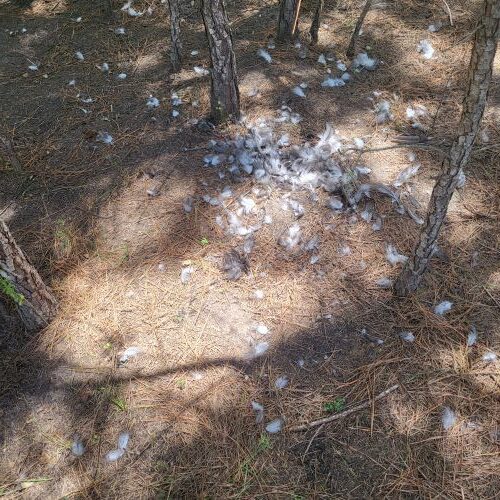
I did not include the image here, but hawks generally can not lift full-grown chickens after the kill and will eat the heads first. If you see a carcass like this, it is almost always aerial (hawk, owl, etc)
